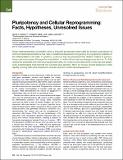Pluripotency and Cellular Reprogramming: Facts, Hypotheses, Unresolved Issues
Author(s)
Hanna, Jacob; Saha, Krishanu; Jaenisch, Rudolf
DownloadHanna-2010-Pluripotency and Cel.pdf (1.347Mb)
PUBLISHER_POLICY
Publisher Policy
Article is made available in accordance with the publisher's policy and may be subject to US copyright law. Please refer to the publisher's site for terms of use.
Terms of use
Metadata
Show full item recordAbstract
Direct reprogramming of somatic cells to induced pluripotent stem cells by ectopic expression of defined transcription factors has raised fundamental questions regarding the epigenetic stability of the differentiated cell state. In addition, evidence has accumulated that distinct states of pluripotency can interconvert through the modulation of both cell-intrinsic and exogenous factors. To fully realize the potential of in vitro reprogrammed cells, we need to understand the molecular and epigenetic determinants that convert one cell type into another. Here we review recent advances in this rapidly moving field and emphasize unresolved and controversial questions.
Date issued
2010-11Department
Massachusetts Institute of Technology. Department of Biology; Whitehead Institute for Biomedical ResearchJournal
Cell
Publisher
Elsevier B.V.
Citation
Hanna, Jacob H., Krishanu Saha, and Rudolf Jaenisch. “Pluripotency and Cellular Reprogramming: Facts, Hypotheses, Unresolved Issues.” Cell 143, no. 4 (November 2010): 508–525. © 2010 Elsevier Inc.
Version: Final published version
ISSN
00928674